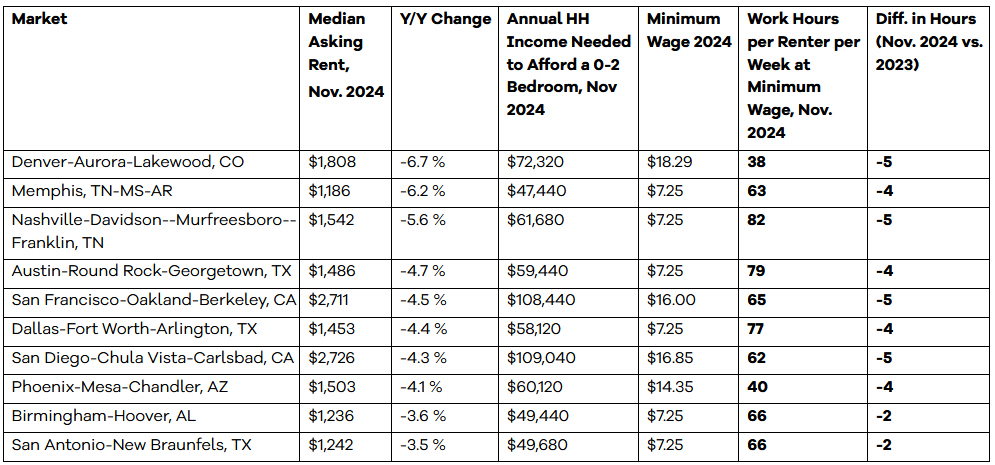  
Back
To News/PR Index
||


|
Santa
Clara, CA – December 2024 / NewsmakerAlert: Rents
declined in November, falling by -1.1% year over year to a median of $1,703,
according to the Realtor.com®
November Rental Report released Monday (December 16). Despite the dip
in rents, affordability remains a concern, with minimum wage earners requiring
extended working hours to afford a typical rental unit in 44 of the top
50 metros in the United States.
“Lower
rents, combined with stable or increased minimum wages, have offered a
break to renters in some metro areas this year, though many minimum wage
earners still struggle to find affordable rents,” said Danielle
Hale, chief economist at Realtor.com®.
“With minimum wages set to increase in more than half of the top 50 markets
next year, and a projected
0.1% annual decline in median asking rents in 2025, we expect some
further relief in the coming year; however, more new construction is still
one of the biggest levers we have to help with affordability.”
To
better understand the hurdles faced by hourly workers in today’s rental
market, this month, Realtor.com® analyzed how many hours per week a
renter would need to work at local minimum wage rates to afford a typical
0-2 bedroom home. Among the top 10 markets with the largest year-over-year
rent declines in November, fewer working hours were required to afford
the median rent compared to the same time last year. Yet only in Denver
and Phoenix could two minimum wage earners each work 40 hours or less per
week and affordably split the median rent for a 0-2 bedroom unit.
|

|
Minimum
wage earners need to work extended hours to afford rents
To
keep their half of the rent at an affordable 30% of their budgets, two
minimum wage earners would have to each work 82 hours per week in Nashville,
Tenn., 79 hours in Austin,Texas and 77 hours in Dallas, despite large year-over-year
rent declines. The affordability crunch is worst in markets that are subject
to the federal minimum wage of $7.25 per hour. But in San Francisco, where
the minimum wage is $16, and San Diego, where it’s $16.85, workers would
still need to work 65 and 62 hours per week respectively to afford the
median rent. By contrast, in Denver and Phoenix, two minimum wage earners
would each need to work 38 and 40 hours per week respectively to afford
the median rent.
Higher
minimum wages and falling rents point to continued relief in 2025
Minimum
wages will rise in 23 of the top 50 markets on Jan. 1, 2025, while additional
markets will see increases later in 2025. If rents hold steady, eight of
those markets are expected to see at least a two-hour reduction in weekly
working hours at minimum wage needed to afford rent. In both St. Louis
and Kansas City, Mo., where the minimum wage is due to rise to $13.75 per
hour from $12.30, two workers earning that wage will each need to work
four hours less per week to afford the median rent. Minimum wage earners
will need to work two hours less in six markets: Sacramento, Calif., Virginia
Beach, Va., Riverside, Calif., San Francisco, New York, and San Jose, Calif.
Release
continues
here...
Media
Contact:
Greg
Taylor
SVP
Marketing
LinkedIn |




